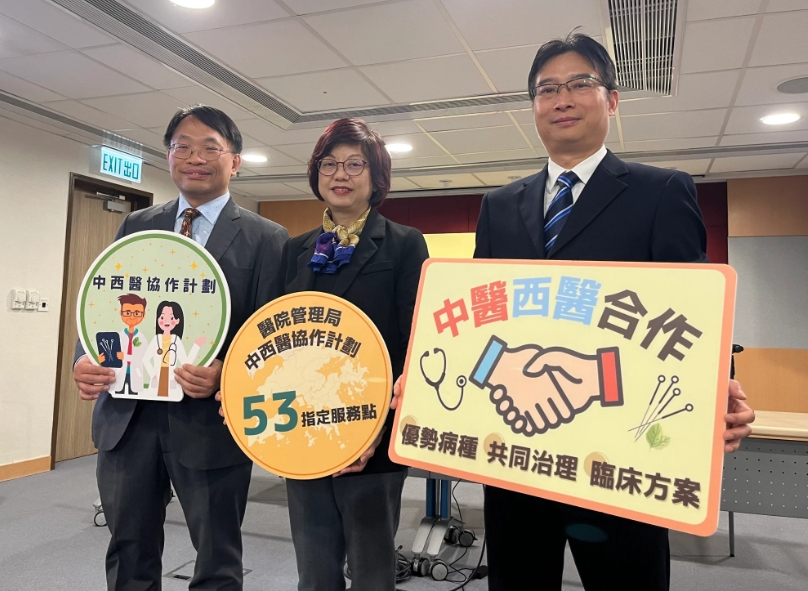
 i_need_contribute
i_need_contribute
Cancer and stroke patients can now get Western and Chinese medicine treatments at 26 Hong Kong public hospitals under a service expansion that also covers people with bone and muscle pain.
The Hospital Authority on Thursday said the Integrated Chinese-Western Medicine Programme had been expanded from eight public hospitals to 26 in the first quarter of the year and covered 53 service points across the city.
“We estimate that we can serve 30,000 patients a year,” Rowena Wong How-wan, the authority’s chief manager of Chinese medicine, said.
“We will also explore the possibility of further expanding the collaborative programme in terms of degenerative diseases and respiratory diseases as our population continues to age.”

(From left) Fong Wing-chi, Rowena Wong and Yau Kin-chung celebrate the expansion of an East-meets-West approach to the treatment of conditions such as cancer and stroke. Photo: Sammy Heung
She added the authority hoped to introduce pilot programmes in new disease areas this year.
The scheme, introduced in 2014, covers four areas – stroke, cancer palliative care, cancer care, and muscle and bone pain.
More than 44,000 patient attendances had been recorded by February.
Patients aged 18 or over are eligible for the scheme. A team made up of Chinese and Western medicine practitioners will invite the patients to join the programme after their suitability is assessed. Each treatment costs HK$120 (US$15).
Wong said the scheme used an evidence-based approach and the Chinese and Western medicine specialists worked together to formulate and adjust treatment plans to ensure safety and integrate both plans.
Doctors from the two disciplines also visit patients and hold discussions on their cases.
Wong said more than 90 Chinese medicine practitioners were involved in the scheme and further recruitment was under way.
The cancer care pilot programme was launched in Princess Margaret Hospital last September and in Tuen Mun Hospital a month later in a bid to relieve some of the symptoms and side effects in patients undergoing a variety of cancer treatments.
Wong said about 400 patients had joined the pilot scheme and it received a good response. She added that the authority might expand the programme to other hospitals in the future.
She said the treatment focused on patients receiving chemotherapy and radiotherapy who suffered neuropathy syndrome – nerve damage that causes pain, weakness, numbness or tingling in one or more parts of the body.
“Patients find it is very useful, especially for numbness and pain relief,” Wong said.
“We will continue to observe the effects of involving Chinese medicine in [cancer] treatments.”
Queen Elizabeth Hospital is one of the existing sites that offer stroke treatments.
Dr Fong Wing-chi, the hospital’s chief of service and chairman of the authority’s Central Committee on Stroke Service, said between last November and January this year, an average of 18 patients a month were given acupuncture – more than 1 per cent of people hospitalised because of an acute stroke.
“We welcome the scheme as collaboration with Chinese medicine practitioners allows patients to receive comprehensive treatments,” he added.
Fong pointed to an elderly woman in her seventies who received acupuncture for stroke rehabilitation, as well as muscle and joint pain.
He said that, after treatment, she told him her use of pain relief pills had been greatly reduced.
Fong added an average of about 30 patients a month would be invited to receive the treatments. But he said some of them would reject the offer because of fear of pain or unstable conditions.
Yau Kin-chung, a senior Chinese medicine practitioner involved in the scheme, said they were able to study hospitals’ patient medical records and doctors were eager to help.
He added practitioners or their assistants stayed with patients throughout the acupuncture process and a record of the number of needles inserted and extracted was logged on the hospital’s computer system.
“The treatment details will be recorded … in case the patient has been transferred to another hospital or visits other government Chinese medicine clinics after being discharged so the continuity of their treatments can be maintained,” Yau said.
But he added some patients were unable to get the treatments because they did not have their Octopus card, the only payment method, on them.
Wong said the authority would examine ways to improve the charging system.
She said fees were at present charged by government-run Chinese medicine clinics rather than the hospitals.